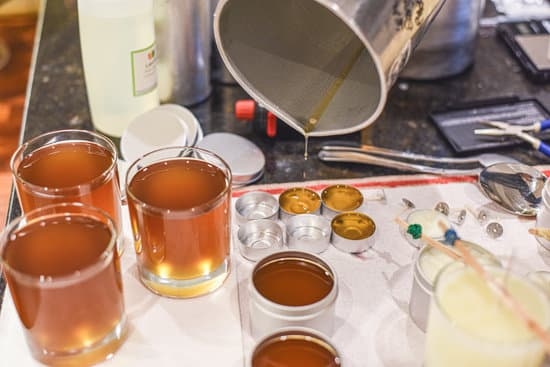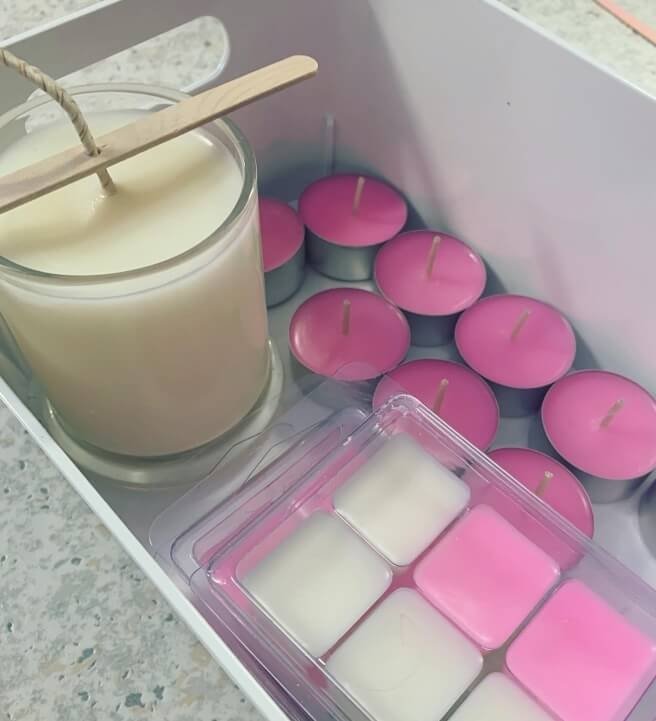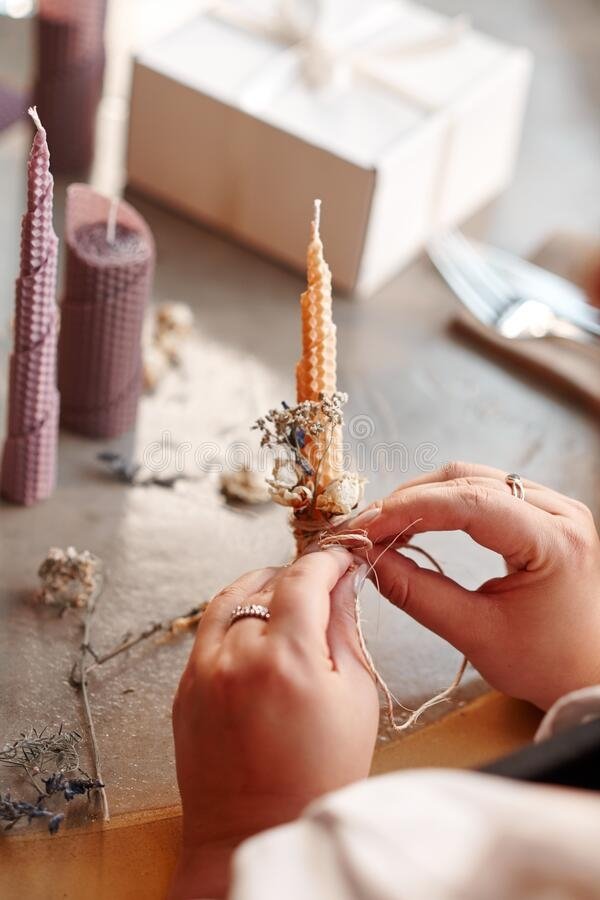The art of candle making has always held a certain allure, with its ability to create a cozy and intimate ambiance in any space. However, if you’ve ever made candles yourself, you might have noticed an unexpected challenge – the presence of holes. In this blog post, we delve into the intriguing world of candle making and shed light on why these holes appear, as well as how to prevent and address them.
Candle making is a craft that goes back centuries, captivating people with its beauty and functionality. Whether it’s for relaxation, decoration, or creating a romantic atmosphere, candles have become an essential element in our lives. But when we embark on our own candle-making journey, we often encounter small holes that form within the wax as the candle burns.
These holes can be frustrating for aspiring candle makers who aim for flawless creations. That’s why it’s important to understand the science behind candle making and how various factors contribute to hole formation. By unraveling the mystery behind these imperfections, we can gain insight into improving our skills and achieving hole-free candles.
In the following sections, we will explore the melting process in candle making and its impact on hole formation. We will also delve into the significance of proper wick placement and how it plays a role in preventing holes from appearing. Furthermore, we will uncover common causes of tunneling in candles and surprising culprits such as air pockets.
With practical tips and troubleshooting strategies along the way, we hope to help you master the art of hole-free candles. So let’s embark on this enchanting journey together.
Understanding the Science Behind Candle Making
Candle making is not just an art, but a fascinating science as well. Understanding the science behind candle making can shed light on why holes often form in candles and how to prevent them. The melting process plays a crucial role in the formation of holes, and factors such as temperature, cooling rate, and wax composition all come into play.
When a candle is lit, the heat from the flame melts the wax near the wick. This molten wax then moves upward through the wick and is vaporized, fueling the flame. However, if there are areas of the candle that do not reach their melting point or cool too quickly, holes can form. This is because the molten wax does not have sufficient time to flow evenly throughout these areas.
The temperature at which wax melts varies depending on its composition. For instance, soy wax has a lower melting point compared to paraffin wax. Therefore, it is important to consider the type of wax being used when making candles to ensure that it melts uniformly and reduces the likelihood of holes forming.
Additionally, the rate at which a candle cools also impacts its structure. If a candle cools too quickly, especially around the edges or near the container walls, it can lead to uneven cooling and potential hole formation.
To prevent holes from forming during candle making, proper wick placement is crucial. The position of the wick affects how evenly heat is distributed throughout the candle and ensures that all areas reach their melting point. If a wick is placed too close to one side or too far away from another side of the container, this can create pockets where heat does not reach efficiently. These unheated areas may later become holes in an otherwise beautifully crafted candle.
In order to achieve optimal results with candles free of holes, it is important to understand and control various factors such as temperature during melting and cooling processes along with proper wick placement within your containers or molds. By doing so, you can create stunning candles that burn evenly and beautifully without any unsightly holes.
The Importance of Proper Wick Placement
Proper wick placement is a crucial factor in preventing holes from forming in candles. A poorly placed wick can contribute to uneven burning, causing the wax to melt unevenly and create holes. To ensure that your candles burn evenly and without any holes, it is essential to understand the significance of wick positioning.
One key aspect of proper wick placement is ensuring that the wick is centered within the candle. An off-center or crooked wick can lead to uneven burning, which may result in holes forming. When placing the wick in the mold or container, make sure it stands straight and upright so that it burns evenly as the wax melts.
Another important consideration for proper wick placement is the distance between the wick and the container walls. If the wick is too close to the edge of the container, it can cause tunneling, where wax melts only in a narrow column around the wick while leaving a significant amount of unmelted wax around the sides. This tunneling effect may eventually lead to holes forming as the unmelted wax collapses inward.
To prevent this issue, follow these steps for proper wick placement:
- Measure and cut your wicks to an appropriate length based on your container size.
- Attach a weighted tab or use hot glue to secure one end of the wick to the bottom center of your container.
- Use a pencil or other tool to make sure your wick stays centered and straight as you pour melted wax into your container.
- For larger containers, consider using multiple wicks spaced evenly throughout for more even burning.
By following these tips for proper wick placement, you can significantly reduce the chances of holes forming in your candles and achieve beautiful, hole-free results.
Wax Pooling and Tunneling
When making candles, one common issue that can lead to the formation of holes is wax pooling and tunneling. Inadequate burning time and improper wick trimming are two factors that contribute to this problem.
Inadequate burning time occurs when a candle is not allowed to burn long enough during its initial use. This can create a small well or pit in the center of the candle, which can eventually lead to the formation of holes.
To prevent this, it is important to allow the candle to burn for a sufficient amount of time so that the wax pool reaches the edges of the container. This will help ensure an even burn and prevent any holes from forming.
Improper wick trimming is another common cause of wax pooling and tunneling. When a wick is not trimmed to the correct length before each use, it can create an uneven burn and cause excess heat in certain areas of the candle.
This can result in the formation of holes as well as tunneling, where a hole forms down the center of the candle while leaving unmelted wax along the sides. To avoid this, it is important to trim the wick to about 1/4 inch before lighting each time.
| Cause | Effect on Candle |
|---|---|
| Inadequate Burning Time | Formation of small well or pit in center leading to potential holes |
| Improper Wick Trimming | Uneven burn, excess heat in certain areas, resulting in tunneling and hole formation |
By understanding these common causes of wax pooling and tunneling, candle makers can take steps to prevent hole formation and ensure a more even burn. Proper burning time and regular wick trimming are essential in maintaining the integrity of the candle and preventing any unwanted holes.
Air Pockets
Air pockets are often overlooked when it comes to understanding the causes of holes in candles. These small pockets of air can play a significant role in creating an uneven burn and ultimately leading to the formation of holes.
One common cause of air pockets is improper pouring technique. When pouring melted wax into a container, it is important to do so slowly and evenly, allowing the wax to fill every crevice and corner. If the wax is poured too quickly or from too high of a distance, air bubbles can be trapped within the wax, creating potential air pockets.
Another factor that can contribute to air pocket formation is the use of poor quality or contaminated wax. Wax that contains impurities or has not been properly filtered may have air trapped within it. When this wax is used to make candles, these trapped air bubbles can lead to holes during the burning process.
To prevent air pocket formation and subsequent hole formation, there are several steps you can take. First, ensure that you are using high-quality, filtered wax for your candles. This will help minimize any potential impurities or trapped air within the wax. Second, when pouring the melted wax into your containers, pour slowly and evenly, allowing the wax to fill all areas without trapping any excess air.
If you do find that your candles have developed holes due to air pockets, there are a few troubleshooting techniques you can try. One option is to gently melt down the top layer of wax around the hole using a heat gun or hairdryer on low heat. This will help even out the surface and potentially cover up smaller holes.
| Cause | Prevention | Troubleshooting |
|---|---|---|
| Improper pouring technique | Pour wax slowly and evenly, filling all areas without trapping air | Melt top layer of wax around the hole using a heat gun or hairdryer on low heat |
| Poor quality or contaminated wax | Use high-quality, filtered wax to minimize impurities and trapped air | N/A |
Finding Solutions
When making candles, it is not uncommon to encounter the frustrating issue of holes forming throughout the candle. Fortunately, there are several tips and tricks that can help you avoid this problem and create hole-free candles.
One important factor to consider in preventing candle holes is proper wick placement. Ensuring that the wick is centered in the candle and reaches all the way to the bottom will allow for an even burn and minimize hole formation. A trick to achieve this is to use a wick centering device or simply secure the wick in place using a clothespin or pencil laid across the top of the candle jar.
Another key aspect to consider is the type of wax being used. Different types of wax have different melting points, which can affect how evenly the candle burns and if holes develop. It is important to choose a wax that is suitable for your desired outcome and be mindful of its composition.
Temperature control during both the melting and cooling process also plays a significant role in preventing holes. Rapid changes in temperature can cause uneven cooling, resulting in pockets of air forming within the candle, which can lead to hole formation. To avoid this issue, it is recommended to follow proper heating instructions for your chosen wax and allow enough time for cooled candles to fully harden before testing or burning them.
By implementing these tips and tricks into your candle making process, you can significantly reduce or even eliminate the occurrence of holes in your finished products. Remember that each candle making experience offers an opportunity for learning and improvement, so don’t be discouraged if a few holes appear along the way. With practice and attention to detail, you’ll soon master the art of creating beautiful, hole-free candles.
Troubleshooting
Identifying the Severity of Candle Holes
When dealing with existing candle holes, it is important to first assess the severity of the issue. Not all candle holes are created equal, and understanding the extent of the problem will help determine the best course of action. Minor holes may be considered a normal part of the candle-making process and can easily be remedied, while larger or more significant holes may require more advanced troubleshooting techniques.
To identify the severity of candle holes, carefully inspect the affected candles. Look for small pin-sized holes or shallow depressions on the surface of the candle. These minor imperfections are often a result of air pockets during cooling and can be easily fixed. On the other hand, larger cavities or deeply tunneled tunnels throughout the length of the candle may indicate more serious issues such as improper wick placement or incorrect burning techniques.
Addressing Minor Candle Holes
For candles with minor holes or shallow depressions, there are several simple solutions to address these imperfections and salvage your candles. One effective method is to use a heat gun or a hairdryer on low heat setting to gently warm up and soften the wax surrounding the hole. Gently press down on the softened wax using a spoon or any non-abrasive tool to mold into shape and fill in the hole.
Alternatively, you can also use melted wax from another candle of a similar color as patching material. Melt down some extra wax using a double boiler method and carefully pour it into the hole while ensuring that it blends seamlessly with the existing wax. Use a toothpick or skewer to level out any excess wax until it matches with the rest of your candle’s surface.
Tackling More Serious Candle Holes
In cases where candles have larger or deeply tunneled holes, addressing them can be more challenging but not impossible. If the hole is large enough, you can use a technique called “candle surgery” to fix the issue. This involves cutting off the top layer of wax above the hole, then heating and melting down additional wax to fill in the cavity. Once the new wax has cooled and hardened, you can re-trim your wick and resume burning.
For candles with tunneling or uneven burn caused by improper wick placement or inadequate burning time, it is best to address these issues before they escalate into larger holes. Properly trimming your wick to a recommended length of about 1/4 inch before each burn and allowing the candle to burn for at least 2-3 hours until a full pool of melted wax forms will help prevent future holes from forming.
By troubleshooting existing candle holes and applying appropriate remedies, you can salvage your handmade candles and ensure their aesthetic appeal as well as functionality.
Aesthetics versus Functionality
In the world of candle making, there is an ongoing debate between aesthetics and functionality when it comes to the presence of candle holes. Some artisans see holes as imperfections that should be avoided at all costs, while others view them as unique features that add charm and character to handmade candles. In this section, we will explore the notion of embracing candle holes as part of their overall appeal.
Appreciating the Unique Features
It’s important to remember that handmade candles possess a certain allure precisely because they are not mass-produced. Each candle is crafted with care and attention to detail, resulting in slight variations that make them truly one-of-a-kind. Holes, whether intentional or not, contribute to this distinctiveness. They can create interesting patterns of light and shadow when the candle is lit, adding a mesmerizing effect to any room.
Furthermore, candle holes can also offer a glimpse into the journey of the flame within the wax. As the wick burns down, it may leave behind tunnels or channels that give insight into how the heat has traveled through the candle. This visual representation of a candle’s burn path can be seen as a testament to its lifespan and history.
Incorporating Holes Into Design
Rather than viewing holes as flaws, they can be embraced for their decorative potential. Creative artisans often find innovative ways to incorporate holes into their designs, turning what could have been considered a flaw into an intentional element.
One approach is to strategically place multiple wicks in a single container candle to create symmetrical or asymmetrical hole formations. These deliberate designs can elevate the overall aesthetic value of the candle by making it appear more visually appealing even before being lit.
Another option is filling existing holes with colorful wax inserts or embedding small decorations such as dried flowers or gemstones. This technique transforms what would have been empty spaces into captivating focal points that draw attention and enhance the overall visual appeal of the candle.
Conclusion
In conclusion, the art of candle making is a fascinating and enchanting process. However, one common challenge that candle makers face is the presence of holes in their finished products. Through understanding the science behind candle making and the factors that contribute to hole formation, it is possible to achieve hole-free candles.
The melting process plays a crucial role in the formation of holes. Factors such as temperature, cooling rate, and wax composition all impact how evenly a candle burns. Proper wick placement is also vital in preventing holes. A poorly placed wick can lead to uneven burning and tunneling, ultimately resulting in holes in the candle.
To avoid hole formation during the candle making process, it is essential to follow best practices. This includes ensuring proper wick placement, allowing for adequate burning time, and trimming the wick regularly. By implementing these techniques, candle makers can increase their chances of creating hole-free candles.
However, it is important to note that sometimes holes are inevitable despite our best efforts. In such cases, there are strategies for dealing with existing candle holes and salvaging candles with minor holes. It is also worth embracing candle holes as unique features of handmade candles and exploring creative ways to incorporate them into designs.
Frequently Asked Questions
Why do my homemade candles have holes?
Homemade candles may have holes for a few reasons. One possible reason is improper pouring technique or temperature control during the candle-making process. If the wax is not poured at the correct temperature, it can create air pockets or voids within the candle, resulting in holes once the wax cools and solidifies.
Another possibility is that the wick used might not be properly centered in the mold or container, causing uneven distribution of wax and leaving gaps. Furthermore, if there are additives like fragrance oils or colorants that are not thoroughly mixed into the wax, they can sometimes separate and create holes as the candle sets.
How do you make candles without holes?
To make candles without holes requires attention to detail and proper techniques. First, it’s important to make sure your pouring technique is precise and consistent. This involves pouring the melted wax slowly and evenly into the container or mold while ensuring that the wick remains centered throughout the process.
Additionally, using a high-quality wick that is appropriate for the size of your candle can help prevent holes from forming. It’s also crucial to thoroughly mix any additives such as fragrance oils or colorants into the wax before pouring to ensure even distribution and minimize any potential separation.
What is the hole in the middle of a candle?
The hole in the middle of a candle is commonly known as a “core” or “tunnel.” This occurs when a candle burns straight down through its center and leaves unburned wax around it in a cylindrical shape. A tunneling candle typically happens because of inefficient burning habits or poor candle maintenance.
If a candle is not allowed to burn long enough during initial use (known as “memory burn”), it can create a small melt pool which only extends as far as its previous burn sessions, resulting in an unused core of wax in subsequent burns. However, with proper care such as trimming wicks to ¼ inch before each lighting and allowing sufficient burn time for the top layer of wax to completely melt across the container/mold, one can minimize tunneling and ensure a more even burn.

Welcome to my candle making blog! In this blog, I will be sharing my tips and tricks for making candles. I will also be sharing some of my favorite recipes.





